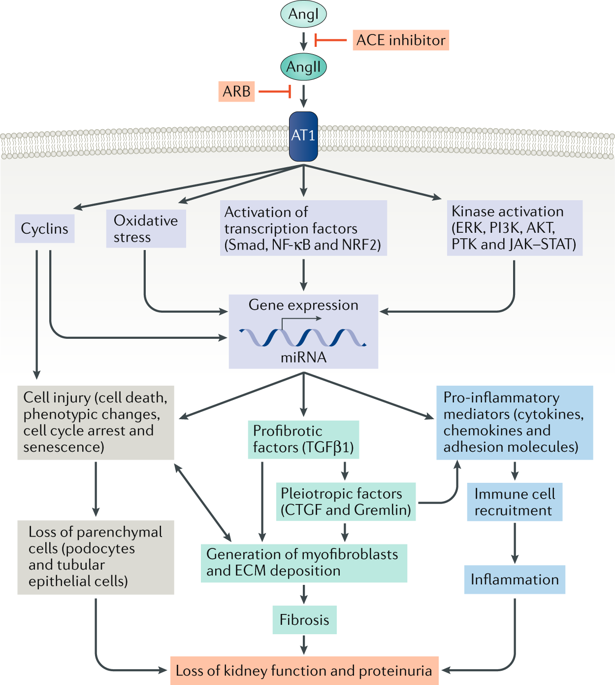当前位置:
X-MOL 学术
›
Nat. Rev. Nephrol.
›
论文详情
Our official English website, www.x-mol.net, welcomes your feedback! (Note: you will need to create a separate account there.)
Targeting the progression of chronic kidney disease.
Nature Reviews Nephrology ( IF 41.5 ) Pub Date : 2020-02-14 , DOI: 10.1038/s41581-019-0248-y Marta Ruiz-Ortega 1, 2 , Sandra Rayego-Mateos 2, 3 , Santiago Lamas 2, 4 , Alberto Ortiz 2, 5 , Raul R Rodrigues-Diez 1, 2
Nature Reviews Nephrology ( IF 41.5 ) Pub Date : 2020-02-14 , DOI: 10.1038/s41581-019-0248-y Marta Ruiz-Ortega 1, 2 , Sandra Rayego-Mateos 2, 3 , Santiago Lamas 2, 4 , Alberto Ortiz 2, 5 , Raul R Rodrigues-Diez 1, 2
Affiliation

|
Chronic kidney disease (CKD) is a devastating condition that is reaching epidemic levels owing to the increasing prevalence of diabetes mellitus, hypertension and obesity, as well as ageing of the population. Regardless of the underlying aetiology, CKD is slowly progressive and leads to irreversible nephron loss, end-stage renal disease and/or premature death. Factors that contribute to CKD progression include parenchymal cell loss, chronic inflammation, fibrosis and reduced regenerative capacity of the kidney. Current therapies have limited effectiveness and only delay disease progression, underscoring the need to develop novel therapeutic approaches to either stop or reverse progression. Preclinical studies have identified several approaches that reduce fibrosis in experimental models, including targeting cytokines, transcription factors, developmental and signalling pathways and epigenetic modulators, particularly microRNAs. Some of these nephroprotective strategies are now being tested in clinical trials. Lessons learned from the failure of clinical studies of transforming growth factor β1 (TGFβ1) blockade underscore the need for alternative approaches to CKD therapy, as strategies that target a single pathogenic process may result in unexpected negative effects on simultaneously occurring processes. Additional promising avenues include preventing tubular cell injury and anti-fibrotic therapies that target activated myofibroblasts, the main collagen-producing cells.
中文翻译:

针对慢性肾脏疾病的进展。
慢性肾脏病(CKD)是一种破坏性疾病,由于糖尿病,高血压和肥胖症的流行以及人口老龄化的加剧,正达到流行病的水平。不管潜在的病因是什么,CKD都是缓慢进展的,并导致不可逆的肾单位丢失,终末期肾脏疾病和/或过早死亡。导致CKD进展的因素包括实质细胞损失,慢性炎症,纤维化和肾脏再生能力降低。当前的疗法具有有限的有效性并且仅延缓疾病的进展,强调需要开发新颖的治疗方法以停止或逆转进展。临床前研究已经确定了几种减少实验模型中纤维化的方法,包括靶向细胞因子,转录因子,发育和信号传导途径以及表观遗传调节剂,特别是microRNA。现在,一些肾保护策略正在临床试验中进行测试。从转化生长因子β1(TGFβ1)阻断的临床研究失败中吸取的教训凸显了对CKD治疗的替代方法的需求,因为针对单一病原过程的策略可能会对同时发生的过程产生意想不到的负面影响。其他有希望的途径包括预防肾小管细胞损伤和针对活化的成纤维细胞(主要的胶原蛋白产生细胞)的抗纤维化疗法。从转化生长因子β1(TGFβ1)阻断的临床研究失败中吸取的教训凸显了对CKD治疗的替代方法的需求,因为针对单一病原过程的策略可能会对同时发生的过程产生意想不到的负面影响。其他有希望的途径包括预防肾小管细胞损伤和针对活化的成纤维细胞(主要的胶原蛋白产生细胞)的抗纤维化疗法。从转化生长因子β1(TGFβ1)阻断的临床研究失败中吸取的教训凸显了对CKD治疗的替代方法的需求,因为针对单一病原过程的策略可能会对同时发生的过程产生意想不到的负面影响。其他有希望的途径包括预防肾小管细胞损伤和针对活化的成纤维细胞(主要的胶原蛋白产生细胞)的抗纤维化疗法。
更新日期:2020-02-14
中文翻译:

针对慢性肾脏疾病的进展。
慢性肾脏病(CKD)是一种破坏性疾病,由于糖尿病,高血压和肥胖症的流行以及人口老龄化的加剧,正达到流行病的水平。不管潜在的病因是什么,CKD都是缓慢进展的,并导致不可逆的肾单位丢失,终末期肾脏疾病和/或过早死亡。导致CKD进展的因素包括实质细胞损失,慢性炎症,纤维化和肾脏再生能力降低。当前的疗法具有有限的有效性并且仅延缓疾病的进展,强调需要开发新颖的治疗方法以停止或逆转进展。临床前研究已经确定了几种减少实验模型中纤维化的方法,包括靶向细胞因子,转录因子,发育和信号传导途径以及表观遗传调节剂,特别是microRNA。现在,一些肾保护策略正在临床试验中进行测试。从转化生长因子β1(TGFβ1)阻断的临床研究失败中吸取的教训凸显了对CKD治疗的替代方法的需求,因为针对单一病原过程的策略可能会对同时发生的过程产生意想不到的负面影响。其他有希望的途径包括预防肾小管细胞损伤和针对活化的成纤维细胞(主要的胶原蛋白产生细胞)的抗纤维化疗法。从转化生长因子β1(TGFβ1)阻断的临床研究失败中吸取的教训凸显了对CKD治疗的替代方法的需求,因为针对单一病原过程的策略可能会对同时发生的过程产生意想不到的负面影响。其他有希望的途径包括预防肾小管细胞损伤和针对活化的成纤维细胞(主要的胶原蛋白产生细胞)的抗纤维化疗法。从转化生长因子β1(TGFβ1)阻断的临床研究失败中吸取的教训凸显了对CKD治疗的替代方法的需求,因为针对单一病原过程的策略可能会对同时发生的过程产生意想不到的负面影响。其他有希望的途径包括预防肾小管细胞损伤和针对活化的成纤维细胞(主要的胶原蛋白产生细胞)的抗纤维化疗法。


























 京公网安备 11010802027423号
京公网安备 11010802027423号